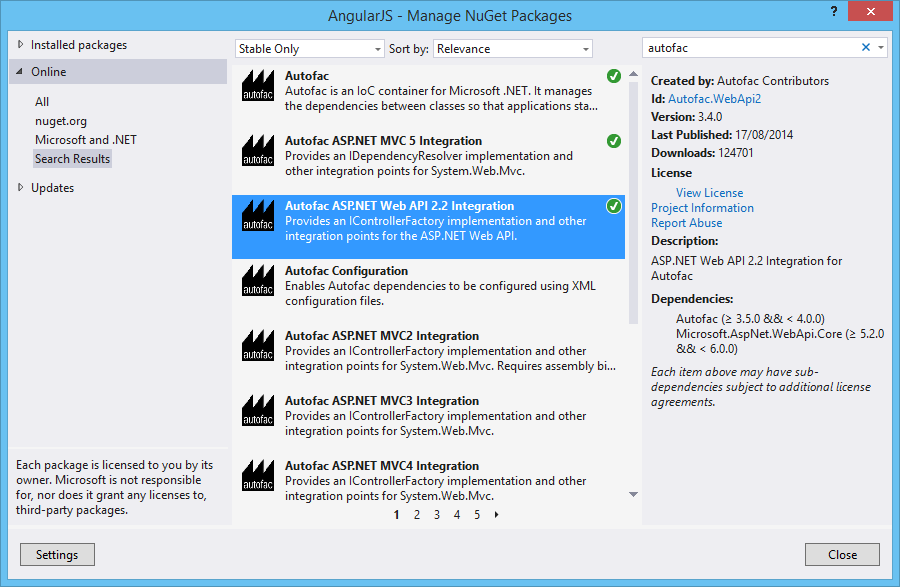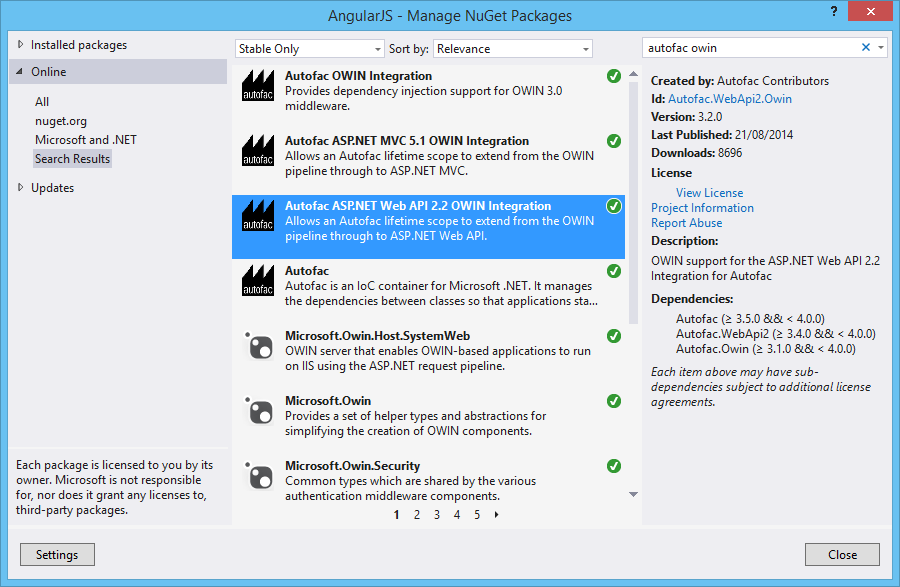Contact List using MVC5, AngularJS and Redis: Part 2 - Install and Configure AutoFac
Introduction
This article walks you through the steps to configure AutoFac (dependency injection) on a MVC + WebApi project.
STEP 1 - Install Nuget
The first step is to add Autofac references to your project.
So on the Visual Studio 2013, select the follow menu option:
- Tools-> Library Package manager -> Manage NuGet Packages for Solutio
- Search for AutoFac and select the options that are checked on the follow image. And select the option Install
This option will install the Nuget Package.
On our project we are using owin integration, so we also need to install dependencies of Autofac to owin.
- Search for "autofac owin", and install Autofac Asp.NET MVC 5.1 Owin Integration and Autofac ASP.NET WebApi2.2 Owin integration.
STEP 2 - Configure Startup file
After we install all necessary packages, we need to configure our startup project:
using System;
using System.Collections.Generic;
using System.Linq;
using Microsoft.Owin;
using Owin;
using System.Web.Mvc;
using System.Web.Http;
using Autofac;
using Autofac.Integration.Mvc;
using Autofac.Integration.WebApi;
using System.Reflection;
using System.Configuration;
using ServiceStack.Redis;
using Services;
[assembly: OwinStartup(typeof(AngularJS.Startup))]
namespace AngularJS
{
public partial class Startup
{
public void Configuration(IAppBuilder app)
{
//Register dependencies with Autofac
var container = RegisterServices();
DependencyResolver.SetResolver(new AutofacDependencyResolver(container));
GlobalConfiguration.Configuration.DependencyResolver = new AutofacWebApiDependencyResolver(container);
app.UseAutofacMiddleware(container);
app.UseAutofacWebApi(GlobalConfiguration.Configuration);
app.UseAutofacMvc();
}
private IContainer RegisterServices()
{
var builder = new ContainerBuilder();
//MVC
builder.RegisterControllers(typeof(MVCApplication).Assembly);
builder.RegisterModelBinders(Assembly.GetExecutingAssembly());
builder.RegisterModelBinderProvider();
builder.RegisterModule<AutofacWebTypesModule>();
builder.RegisterSource(new ViewRegistrationSource());
builder.RegisterFilterProvider();
//WebApi
builder.RegisterApiControllers(Assembly.GetExecutingAssembly()).PropertiesAutowired();
return builder.Build();
}
}
}
Resources
- My personal blog: http://joaoeduardosousa.wordpress.com/
- AutoFac official site: http://autofac.readthedocs.org/en/latest/
More articles in this series
- Contact List using MVC5, AngularJS and Redis - Part1 - How to Setup MVC with WebApi
- Contact List using MVC5, AngularJS and Redis - Part 2 - Install and Configure AutoFac
- Contact List using MVC5, AngularJS and Redis - Part 3 - How to Setup AngularJS
- Contact List using MVC5, AngularJS and Redis - Part 4 - How to Setup Redis
- Contact List using MVC5, AngularJS and Redis - Part 5 - Create CacheService to communicate with Redis
- Contact List using MVC5, AngularJS and Redis - Part 6 - Create Contact Controller on WebApi
- Contact List using MVC5, AngularJS and Redis - Part 7 - Configure AngularJS
- Contact List using MVC5, AngularJS and Redis - Part 8 - Retrieve and display tabular data with AngularJS
- Contact List using MVC5, AngularJS and Redis - Part 9 - Create Simple Insert Form using AngularJS

